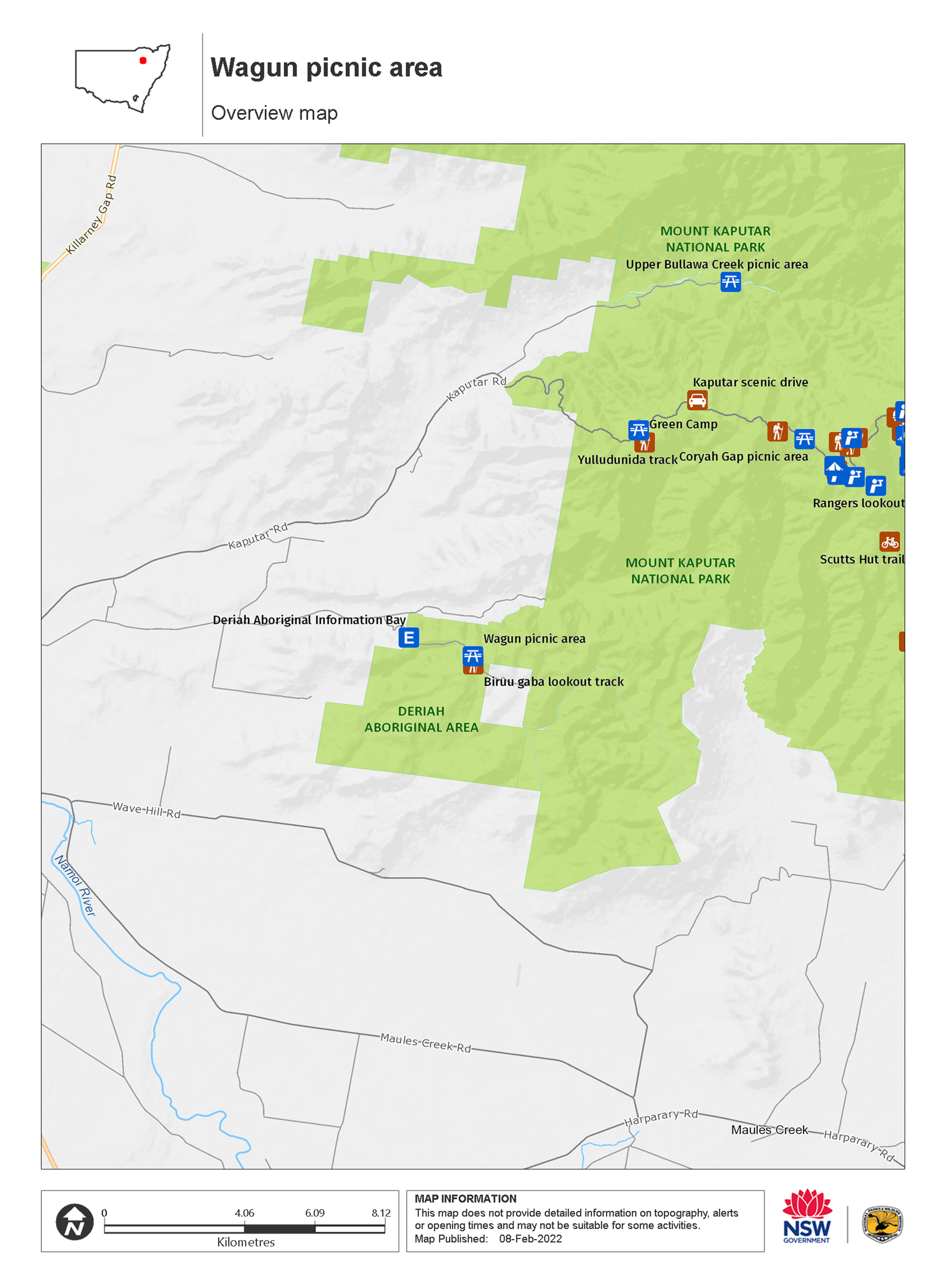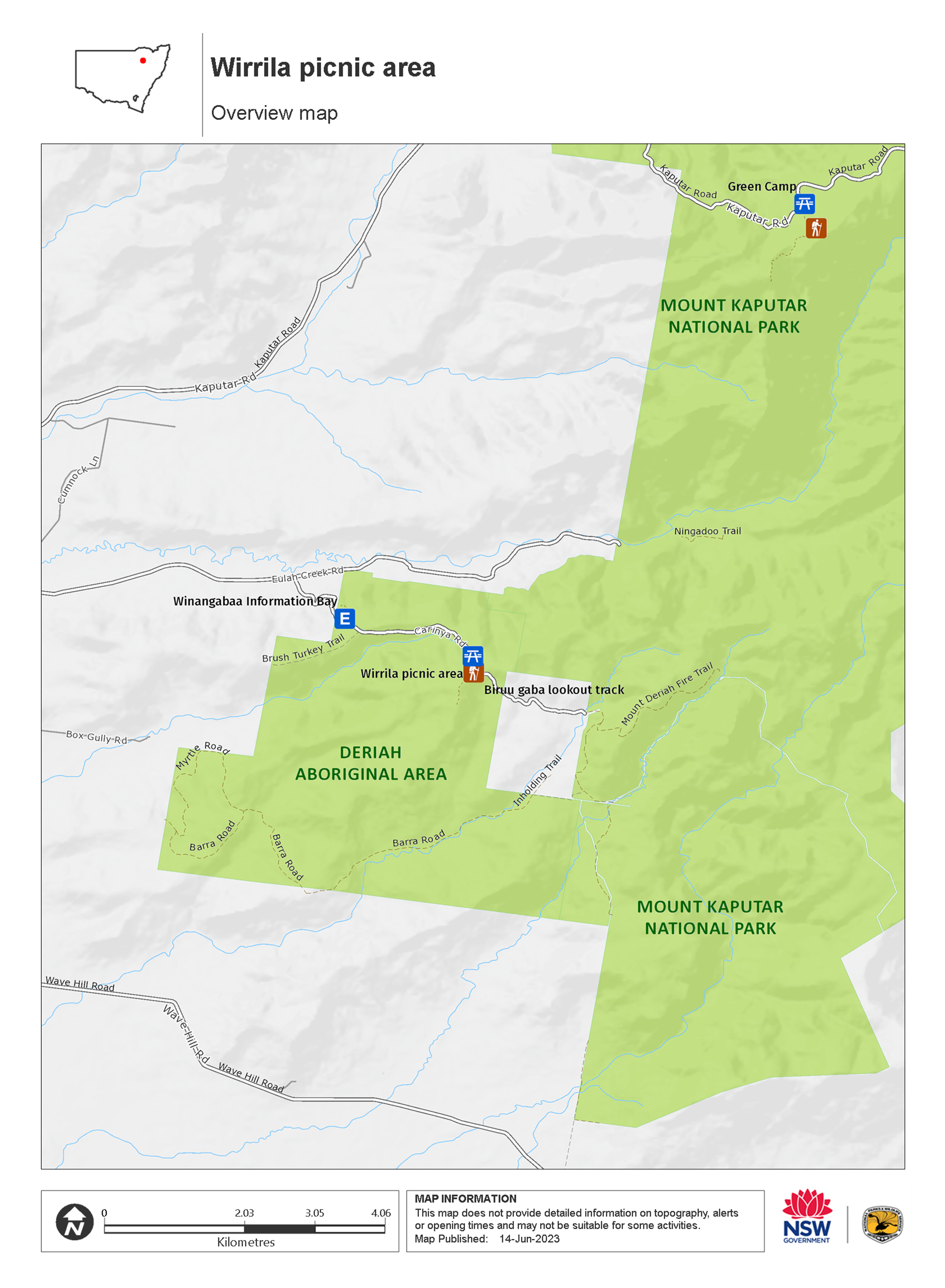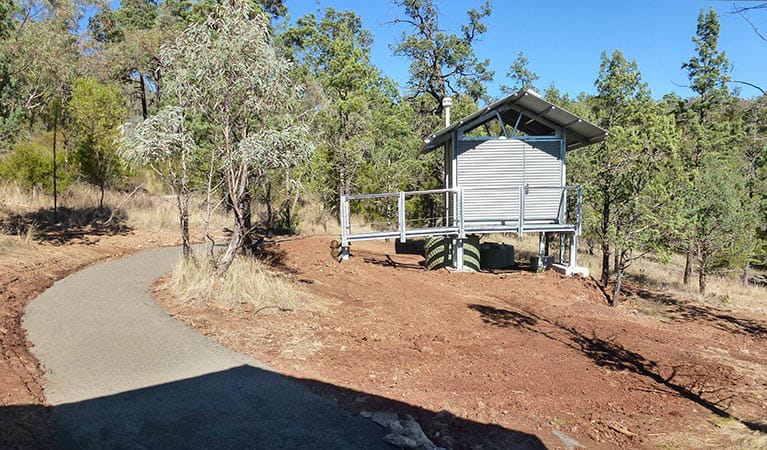Wirrila picnic area
Deriah Aboriginal Area
Overview
A highlight of Deriah Aboriginal Area, near Narrabri, is wheelchair-accessible Wirrila picnic area. Ideal for families, the kids will love Culture Sculpture walk.
- Type
- Picnic areas
- Where
- Deriah Aboriginal Area in Country NSW
- Accessibility
- Easy
- What to
bring - Hat, sunscreen, drinking water
- Please note
- There is limited/no mobile reception in this park
- Remember to take your binoculars if you want to go bird watching
Nestled on the slopes of Nandewar Ranges, Wirrila picnic area offers a tranquil bush setting for a family get-together in Deriah Aboriginal Area, near Mount Kaputar National Park and Narrabri. Enjoy a barbecue lunch while learning about the unique culture of the local Gamilaraay People, in this peaceful picnic area.
After lunch, enjoy a short walk around Culture Sculpture loop walk, where you’ll see several sculptures of animals that feature in traditional stories and represent totems for the Gamilaraay People. The kids will love to discover ‘How the goanna got its stripes’ and ‘Why the brush turkey lays its eggs in the ground’.
Soak up the tranquil views across the cypress ironbark forest and if you’re into birdwatching, keep an eye out for the diamond firetail, speckled warbler and the brown treecreeper. If you’re keen to explore further, don’t miss the spectacular views from Biruu gaba lookout walking track.
Map

Map legend

Map

Local alerts
For the latest updates on fires, closures and other alerts in this area, see https://www.nationalparks.nsw.gov.au/things-to-do/picnic-areas/wirrila-picnic-area/local-alerts
General enquiries
- National Parks Contact Centre
- 7am to 7pm daily
- 1300 072 757 (13000 PARKS) for the cost of a local call within Australia excluding mobiles
- parks.info@environment.nsw.gov.au
Park info
- in Deriah Aboriginal Area in the Country NSW region
Deriah Aboriginal Area is always open but may have to close at times due to severe weather or extreme fire danger.
Visitor info
All the practical information you need to know about the Wirrila picnic area.
Getting there and parking
Wirrila picnic area is in Deriah Aboriginal Area and located on Carinya Road.
To get there from Narrabri:
- Drive south-east along Old Gunnedah Road for 3km, then turn left onto Kaputar Road.
- After 9km, turn right onto Eulah Creek Road and continue for 5km until you reach the unsealed section.
- Follow the unsealed section of Eulah Creek Road for 6km, past the olive farm, before turning right onto Carinya Road.
- Follow this route up the hill to enter Deriah Aboriginal Area
- After 1km you'll see the information bay on the left
- From the information bay, travel east along Carinya Road for 2km and Wirrila picnic area is on your right.
Road quality
Check the weather before you set out as the road to Wirrila picnic area can become boggy when it rains.
- Mixture of sealed and unsealed roads
Vehicle access
- All roads require 4WD vehicle
Weather restrictions
- Dry weather only
Parking
There's parking at the picnic area in a gravel carpark, including bus parking (one small bus space).
Best times to visit
There are lots of great things waiting for you in Deriah Aboriginal Area. Here are some of the highlights.
Autumn
Enjoy bushwalking or mountain biking along the area's roads and trails.
Spring
A spectacular time to enjoy the activities of the area's abundant birdlife and wildlife.
Summer
Escape the heat of the plains in the dry rainforest, where you can enjoy bushwalking and picnicking as well as a range of cultural activities.
Winter
Soak up the sun while enjoying a picnic and take advantage of the scenic views available on a clear winter day.
Weather, temperature and rainfall
Summer temperature
Average
19.4°C and 35.3°C
Highest recorded
43.3°C
Winter temperature
Average
3.4°C and 17°C
Lowest recorded
-5.6°C
Rainfall
Wettest month
January
Driest month
August
The area’s highest recorded rainfall in one day
188mm
Facilities
Drinking water is not available in this area, so it’s a good idea to bring your own.
Toilets
There are accessible micro-flush toilets at the picnic area.
- Flush toilets
Picnic tables
Barbecue facilities
- Gas/electric barbecues (free)
Carpark
Step-free access
There is step-free access to the picnic area along a roadbase pathway that leads from the carpark.
There's also a roadbase culture sculpture walk next to the picnic area, but this walk has a series of low steps.
- Step-free outdoor pathways
Seats and resting points
There are 2 large, flat wooden bench seats without backrests along the culture sculpture walk next to the picnic area.
Maps and downloads
Accessibility
Disability access level - easy
Wirrila picnic area is flat and step-free, with roadbase pathways that lead from the carpark to the facilities and accessible toilets.
There's a culture sculpture walk next to the picnic area that has a number of low steps. You may need assistance in this area.
Prohibited
Pets
Pets and domestic animals (other than certified assistance animals) are not permitted. Find out which regional parks allow dog walking and see the pets in parks policy for more information.
Smoking
NSW national parks are no smoking areas.
Learn more
Wirrila picnic area is in Deriah Aboriginal Area. Here are just some of the reasons why this park is special:
Ancient volcanic landscape

The region offers spectacular scenery of steep volcanic rock cliff lines and soft sandstone that has eroded over time into unique formations. The volcanic rocks were created by eruptions that formed the Nandewar Range shield volcano, around 19-21 million years ago. Lava flows were pushed out from beneath the earth’s surface and spread across the land. The lava cooled when it was exposed to the air and hardened to make new rocks.
Bird watching paradise

The Deriah forest region protects a huge and diverse range of bird species, including numerous threatened and significant bird populations. Take your binoculars for a chance to see spotted harrier, little eagle, little lorikeet, black-chinned honeyeater, rainbow bee-eater and hooded robin. A number of species, including the superb parrot, turquoise parrot and speckled warbler, are listed as vulnerable.
Education in the forest

An innovative education package is available for Deriah Aboriginal Area. It aims to incorporate Aboriginal cultural heritage into all aspects of the curriculum. The package provides teachers with excursion options and activities within Deriah forest for stage 1-3 of the NSW Syllabus.
Gamilaraay country – Gamilaraay culture

Deriah Aboriginal Area is of high cultural value to the local Aboriginal community and contains important evidence of their lives in the area, with a large number of significant sites recorded including scarred trees and grinding grooves. The exact origin of the name ‘Deriah’ is unknown, although it may have come from the Gamilaraay word ‘dhiriya’, meaning ‘old’. Deriah Aboriginal Area Co-management Committee was formed in 2008 to work in partnership with NPWS to help guide management of the reserve and encourage connection with country. This committee consists of Aboriginal community members from Narrabri who represent Gamilaraay families with a historical connection to the area.

